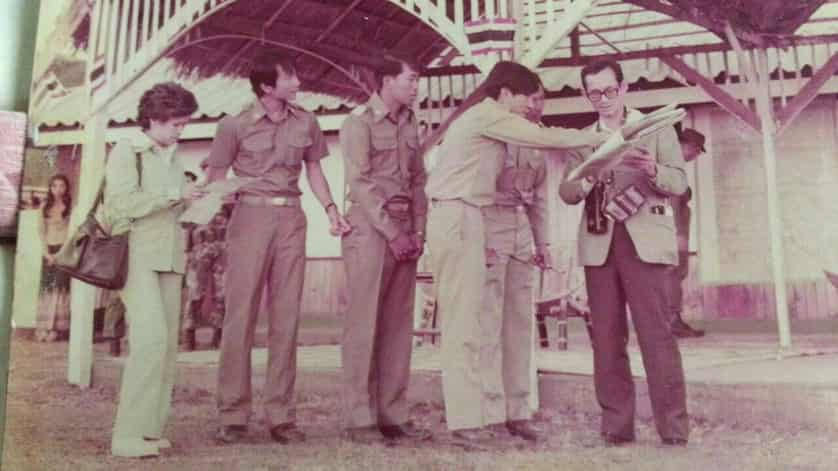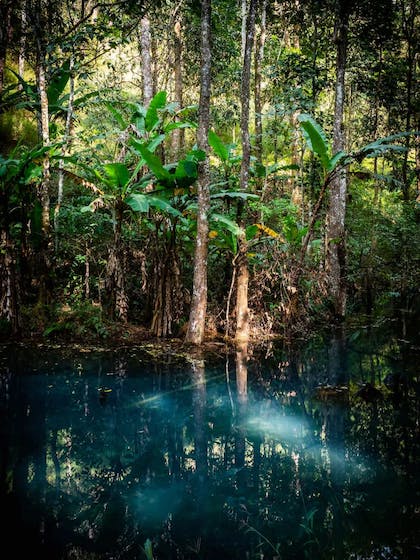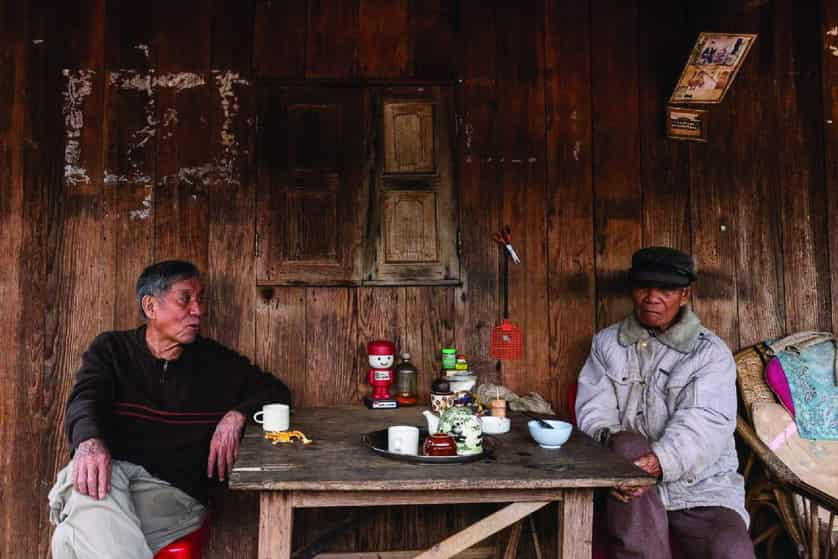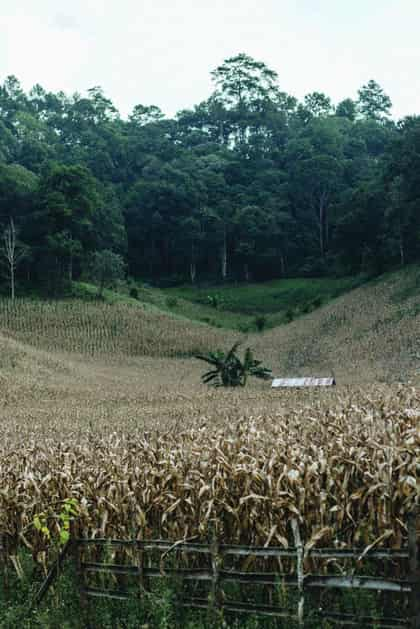His weathered hands, marked with deep lines and prominent veins, swept through the air, a finger pointing towards the endless cornfields lining the mountain slopes around us. Where corn now grows, he told us, was once the forest he spent over a decade creating.
Dr. Samart Sumanochitraporn, fondly nicknamed Mr. Can Do, was only 25 when he was assigned to the Water Source Protection Unit in Doi Sam Muen in response to an order issued by His Majesty the late King Bhumibol Adulyadej. The denuded mountains, which spread across Chiang Dao District in Chiang Mai to Pai District in Mae Hong Son, was, on his arrival half a century ago, blanketed with opium fields. Now, at the age of 71, memories of working side by side with the King are still vivid in his mind. Having followed His Majesty’s advice throughout his career, he had succeeded in returning much of the mountain to its lush forest state, regenerating water resources which thousands of households depended upon as well as helping local people find a way to sustain themselves. His recent return is bitter-sweet, as he has reconnected with villagers he worked with so long ago, only to find that much of his life’s work has been undone, as the mountain faces a new environmental crisis.
Royal Outreach
“Due to conflicts in China, from the days of the opium war, the Sino-Japanese war through to the Chinese civil war, many mountains along the border areas saw an influx of migrants who ended up living side by side with existing tribal people,” said Dr. Samart of the proliferation of opium which began to cause both a social and environmental scourge by the mid-20th century. “Forests were being encroached upon, mountains were bald of trees and water resources became scarce as more natural forest land was being replaced by opium fields.”
“It wasn’t until 1958 that opium was officially decreed illegal in Thailand. But due to the remote region and dangerous terrain, the change of law didn’t affect the proliferation of opium cultivation. It was around that time that the late king’s mother, Princess Srinagarindra, started to visit the isolated border areas on behalf of the king,” explained Dr. Samart. In 1960, the late Princess signed the Wild Animal Reservation and Protection Act. A few years later a national watershed development initiative was established on Doi Pui, at the time home to one of the largest opium fields in northern Thailand. At the same time the royal family, which had been visiting rural areas with greater frequency, initiated several projects including the Border Patrol Police School and later, the Royal Project; this was the beginning of a decades-long focus on highland agriculture development. “The Princess Mother personally gave 20,000 baht to build a school and teacher’s residence in Doi Sam Muen and she came to the mountain for the opening ceremony in 1967,” said Dr. Samart of the first royal visit to this isolated mountain. While most of the forest was gone, there were still wild tigers and elephants roaming the area. Goods were transported by horses and oxen. By 1970, HM the late King Bhumibol Adulyadej along with Her Majesty Queen Sirikit came by helicopter to Ban Sam Muen for the first time. By that time the King had become increasingly concerned for the welfare of his mountain subjects, many of whom were poverty stricken and addicted to opium. He also recognised that the mountains of the north of Thailand were the source of much of the nation’s water supply and that prolonged damage to its ecology could greatly affect millions downstream. He began to actively seek help from academic researchers in Thailand’s leading universities to find replacement crops to be used to wean the mountain people off opium. A decade later, an international initiative was born, and the success story that is the Royal Project received awards and recognition from world leaders from leaders of the UN to President Bill Clinton.
“The Royal Thai Police signed an MOU with the UNFDAC (United Nations Fund for Drug Abuse Control) and the Thai/UN Highland Agricultural Marketing and Production Project (HAMP) begun. The project’s subjects are in five areas, including Doi Sam Muen. Later, the project was absorbed by several offices including the Office of Narcotics Control Board, and part of it became a watershed management unit under the Royal Project,” said Dr. Samart explaining the background of what is now the Watershed Conservation and Management Office.

Danger: Red Zone
“I was the youngest to be appointed as the head of the Royal Watershed Development Project Unit No.9 (Huey Nam Ru ) Doi Sam Muen,” said Dr. Samart. After graduating from the Faculty of Forestry, Kasetsart University he was sent to work in Rayong Province and shortly afterwards to spearhead the Watershed Management Unit in Doi Sam Muen. “The King used to visit the university and perform his music, and then he would tell the story of his works in the mountain areas of the north. I have always been inspired by his work,” said Dr. Samart. Back in 1974, Doi Sam Muen was a ‘red zone’ which meant that it was a dangerous no-go area infused with drugs and traffickers. Dr. Samart was a forestry officer tasked with going into this ‘red zone’, where there were over 10,000 rai of opium fields, to convince hill people to cease growing opium and help him to regenerate the forest . “There were all sort of dangerous people — gangsters, mafia — you name it,” said Dr. Samart whose purview covered 18 villages across Doi Sam Muen. The mix of ethnicities added to the challenge as he had to work with Chinese migrants, Lisu and Lahu people. “Gunshots were often heard in the middle of the night.” It was so dangerous that although much of the time he worked alone, once the border patrol police was sent to camp near him for added security. His gun was always within his reach in this northern Thai version of the wild wild West. “Twice I attended ‘seminars’ where all who attended were wearing balaclavas.”
The area was almost inaccessible by land. “I had to follow elephant trails; they are big creatures so they need the simplest route to traverse. What’s interesting is that over a decade later when I eventually built the road, I built it along that same trail. One time, my team and I had to hide to avoid an encounter with wild elephants; it took us almost all day to get out of the hiding spot.”
In 1976, HM the King visited Doi Sam Muen again. “He was in better shape than many of us,” smiled Dr. Samart as he recalled the memory of the King walking ahead as they visited villages, leaving the rest of the team, including the queen, behind. During our visit to the mountain for this article, we found ourselves at a resting spot in the dense forest — a shack with a plain wooden table and logs to be used as chairs. “He stopped right here to rest and we soon discovered that there was crystal clear water coming out of a hole nearby, the slow flow creating an emerald green pond surrounded by lush plants.” The discovery of this water resource led to a royal order to survey the area to divert this water to various villagers which also helped with rice cultivation.
“All of our water comes from the forest, so the forest must be protected,” said Dr. Samart simply. He explained that the king often used simple words, “He would say, ‘do not bully the natural forest’, teaching us to plant trees on mountain ridges, use the slopes to plant a diversity of fruit trees and plant rice on terraced steps of the lower slopes. He said it clearly. With this assessment, villagers could live using only three to five rai of land.” Dr. Samart spent over a decade following these simple royal words.

Breaking the Ice
“The most important thing is trust. They needed to know that we were not taking advantage of them,” said Dr. Samart referring to the principles — understanding, connecting, and developing — he picked up by working with the king. At the time uneducated and poverty-stricken mountain people were feared and reviled by many across Thailand who looked down on them because of their poor appearance while blaming them for Thailand’s drug problems. This resulted in decades of misconception about mountain people and their deep resentment and distrust of lowlands people. Taking HM’s advice to heart, Dr. Samart started to build relationships. He would spend 25 days per month visiting and living among the villagers, taking a long weekend into Chiang Mai to get his paycheck and replenish his supplies before heading up again. As most villagers were working the fields during the day he would walk to villages for visits in the evenings. Language was one of the greatest barriers, and Dr. Samart soon realised that he needed help. He identified smart youths and sent them to Chiang Mai for education. Once they returned to Doi Sam Muen, these men were invaluable to his efforts to rejuvenate the forest, though he also said that some had a duel role in that they were also tasked with warning him when there was a hit out on him by one of the drug lords.
And there was a lot of dinking. “My back was always wet from pouring the booze over my shoulder. You know, in the dim light no one really notices anything. If I drank it all, I’d probably be dead by now. Their moonshine was really strong,” said Dr. Samart with a laugh. He described his task as ‘general serf.’ “It’s not like being a head of the unit and I can walk around with my nose high.” Little by little, he gained the trust of the villagers, mostly by doing minor favours. “I gave villagers rice when they had nothing to eat, took them to the hospital when I came to town and when the road was eventually built, would take their children to school.” His deep relationships with many people in these far-flung communities (it took us four hours to drive to Doi Sam Meun from Chiang Mai city) is evident today, as we followed him as he walked up to people’s houses and was greeted like a long lost relative by many of the people we met.

Mission Accomplished
“Villagers need to be able to live with the forest.” Dr. Samart said. The aim was to not just restore the forest, but also to make sure that edible plants are grown to sustain the people. “The king’s vision was great. The approach was simple; fill the area with what grows best.” Those plants also needed to produce high yield on unhealthy and degraded land. It was soon agreed upon that peaches, persimmon and coffee would be the best choices. Dr. Samart explained that villagers weren’t keen on tending to difficult plants. So, he needed plants which were easy to grow and care for, bearing fruit year-round. “Villagers didn’t even know how to grow rice at that time, so I had all the saplings flown here by helicopter and created demonstration plots where villagers could learn.”
The first coffee saplings were similarly delivered via police helicopter in 1973. Doi Sam Meun was one of the first locations where coffee (Arabica) was grown in Northern Thailand, before the Royal Project followed suit, making Dr. Samart one of the pioneers of what has becoming the massive industry it is today. Though the saplings would take five years to bear fruit and decades longer to find a thirsty market, it was only one of numerous plants Dr. Samart introduced to the area. Incredibly, four years later, the newly mature coffee beans from the mountain were taken to Geneva where they were ranked second best coffee in world.
Dr. Samart literally planted whatever grew best; seeds were sewed on barren land, stumps were left to shoot new branches, and as monoculture was replaced by this new method, things began to grow…and bear fruit. By the time HM King Bhumibol Adulyadej visited Doi Sam Muen for the third time in 1977, Dr. Samart was able to show his majesty 2,300 rai of planted plots. After a few years, Doi Sam Muen was able to produce over 800 tonnes of potatoes a year along with other fruits, vegetable and decorative flowers. “I often sent the produce to the King,” he said proudly. “Every time I came down the mountains I would see trucks lining up at the entrance of Huay Nam Dung waiting for our produce.” He laughed when he recalled the day he found out that a potato farmer was able to buy gold.
Today, 40,000 rai of bald mountain have been replanted, thaks in part to Dr. Samart’s efforts. “Due to the success of Doi Sam Muen, academics and research groups started to visit from all over the world,” boasted Dr. Samart. “I was also driving the area to become a tourism destination. But then one day the State Audit Office came knocking on my door. They said that what I was doing was not supported by the law. The issue was that villagers did not own the land they were cultivating. They said that with so much attention on the area, and all the money pouring in, the law couldn’t turn a blind eye. So I opened a national park covering it all!”
Following a 1987 survey, Huay Nam Dung National Park was opened three years later and Doi Sam Muen is today part of it. “When the area is labelled as protected forest, Thai citizens were able to apply for permission for land use. I also succeeded in forming a network of villages, run by people within the communities and supervised by the Watershed Management Unit and the National Park.”
In 1990, 16 years after his first appointment, Dr. Samart officially moved to work at Doi Tung following a summon by the Princess Mother. He worked there for a further 16 years before being appointed head of the Wildlife Conservation Office, a job he held for a couple of years until his retirement.
“In 2010, I visited Thale Noi Palace to inform Princess Sirindhorn of my retirement. She kindly asked for my generosity to help her out,” he smiled. His first task post-retirement was to develop 12 villages along the border in Chiang Rai and Mae Hong Son. Co-incidentally a delegation of villagers from Doi Sam Muen had at the same time come to him, begging him to return as they didn’t have enough to eat. “They said five of them had been shot dead by drug traffickers. When I asked them why they returned to drugs they said, ‘if we don’t get caught, we get rich; but if we are arrested, at least there are full meals at the prison’. You see,” sighed Dr. Samart, while shaking his head in disappointment.

Old Man Returns
Citylife spent two days and one night trying to keep up with the very fit and active 71 year old Dr. Samart, as we visited villages across Doi Sam Muen. We followed him as he discussed villagers’ concerns about forest fires in the upcoming season. We listened to weighty discussions about sharing responsibilities between villages that were in different district boundaries. We heard villagers plead for roads to be built and electricity lines to be extended to remote villages. While there are some partial concrete roads in the area, most are in such bad condition all that remain are their iron foundations. We took a drive to follow in the royal footsteps: looking out at an area where once their majesties were deeply concerned to see fields of poppy flowers; an area which Dr. Samart spent 16 years rejuvenating and bringing back to life; and an area today barren but for endless lines of corn, golden fields ploughed into the dwindling forests like a bad haircut. Tree trunks rotting on the ground.
The emerald panel. Even the stepped paddy fields on the lower slopes were now covered with corn. “The king told me to divert water to this area so the villagers could grow rice,” sighed Dr. Samart, who was stunned to see that rice had also been replaced by golden corn fields. When we arrived at the coffee research plantation we were similarly disheartened to see the trees left unattended, berries withering on boughs. The research stations and sub-units were left almost abandoned, including the building which housed their majesties. The Watershed Management Unit, where a sign proclaimed, ‘Mr. Can Do’s House’, which used to have 100 members of staff by the end of Dr. Samart’s tenure, had shrunken to fewer than ten.
“The problem is that the policy is not consistent. When the director changes, the policy changes, and the rest just have to dance along,” he said in frustration.
“In this kind of work you need to be tough, not just with the villagers, but also with the central bureau. Fighting for budget is even harder these days. It’s like having one leg shackled. Princess Sirindhon said to me that the older generations really knew the area, knew the people and knew the royal initiative, unlike the young generations,” pointing to the disconnections in the lines of communication where officials were not in any one place long enough to bond with the community, policies were inconsistent and budgets were tight. It was sad to see so much of his work undone.
However, all is not lost. Accompanying us on our trip to Doi Sam Muen was Naruemon Taksaudom, Managing Director of Hillkoff, the first company to find a market for Chiang Mai’s Arabica, which has been a powerhouse in growing the Northern coffee industry. She is the market to Dr. Samart’s plan for coffee cultivation in Doi Sam Muen. Not just any coffee, his aim is specialty coffee which the area has the potential to produce. While discussing this new strategy, we found ourselves standing in the dirt yard of a village headman’s house. This young man had shown a particular interest in Dr. Samart’s coffee plan and as we looked out at the views of the grass- and corn-covered mountains, Dr. Samart asked him “remember when this was a coffee forest and everywhere you looked you would see beautiful peach blossoms?” The headman nodded, adding that it was but a childhood memory. Dr. Samart simply said, “It was my work.”
“I am old and my time can end at any moment. I cannot go up and down the mountain like I used to, my car is ruined and my wife doesn’t like it,” said Dr. Samart with a smile. “The vital thing is that the villagers be sustainable, that they don’t starve and that they can live with the forest without destroying it. I will continue to support and carry out the king’s works as best I can and for as long as I can.”
